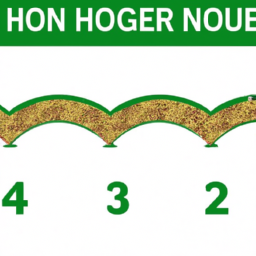Garden Hose Flow How Many GPM
How Many Gallons Per Minute Is A Garden Hose
Understanding the Volume Produced by a Garden Hose
Garden hoses are essential tools for watering gardens, lawns, and other landscaping. But with so many types on the market, it can be difficult to know which will best serve your needs. To help users determine the right garden hose and select features, this guide will explore the gallons per minute (GPM) a garden hose can produce, as well as other considerations such as hose diameter, material type, and maintenance requirements.
Features of a Garden Hose
When considering a garden hose, there are a few important characteristics to consider including hose diameter, material type, coupling type, and length. Hose diameter is typically measured in 1/2 inch increments and is the most important factor when considering GPM production. Also of importance is the material type of the hose most are made of either rubber or vinyl. Coupling types refer to the connections between sections of a garden hose, and most suppliers will feature coupled and non-coupled variations. Finally, garden hoses come in a variety of lengths ranging from 25 to 200 feet.
Benefits of a Garden Hose
The obvious benefit of a garden hose is that it allows for easy and efficient watering of gardens and lawns. Garden hoses are lightweight and generally inexpensive, which makes them an accessible tool for do-it-yourselfers. Garden hoses are also flexible and can be maneuvered around gardens with ease, giving gardeners the ability to reach far corners of their landscape.
Pros and Cons of a Garden Hose
The biggest pro of a garden hose is its convenience and functionality. Garden hoses are an affordable and easy way to keep yards and gardens well-watered. Garden hoses also come in a variety of sizes so users can choose the size that best suits their needs, and they're relatively easy to store.
On the other hand, garden hoses can be prone to leaking and can sometimes be difficult to store. To reduce the opportunity for leaks and damage, hoses should be drained and hung in a dry, cool place when not in use. Additionally, garden hoses may not be suitable for large areas.
2-4 Case Studies
Case Study 1: Small Garden 25 Feet Garden Hose
For smaller gardens, a 25 foot garden hose may provide the perfect balance of convenience and coverage. With a 25 foot garden hose, users can easily cover the length of a standard garden, allowing them to water plants and flowers in hard-to-reach corners. 25 foot garden hoses can produce up to 0.45 GPM, which is enough for most gardening tasks.
Case Study 2: Medium Garden 50 Feet Garden Hose
For larger gardens, a 50 foot garden hose can be a great solution. With a length of 50 feet, users can cover more distance and will be able to access plants and flowers in far corners of the garden. 50 foot garden hoses have greater GPM, up to 0.7 GPM, which is ideal for heavier tasks.
Case Study 3: Large Garden 100 Feet Garden Hose
For the most expansive gardens, a 100 foot garden hose is likely the best choice. Its length can provide wider coverage, and 100 foot garden hoses can produce up to 1.2 GPM. This is an ideal solution for larger gardening and landscaping tasks.
FAQ's
Q: How Many Gallons Per Minute Does a Garden Per Minute Produce?
A: The amount of GPM a garden hose can produce depends on the hose diameter and length. Generally, the smaller the diameter and the longer the length of the hose, the greater the GPM output. For example, a 25 foot, 1/2 inch diameter garden hose can produce up to 0.45 GPM, while a 50 foot, 1/2 inch diameter garden hose can produce up to 0.7 GPM.
Q: What Diameter is Standard for an Average Garden Hose?
A: Garden hoses are typically sold in 1/2 inch increments. The most common sizes for garden hoses are 1/2 inch, 5/8 inch, and 3/4 inch. Larger diameter hoses will typically produce greater GPM, but it is important to consider distance and weight when selecting a garden hose.
Mistakes People Make
One of the most common mistakes people make when selecting a garden hose is underestimating the size of their garden. Without an accurate assessment, users can pick hoses that are either too short, or too long, for their needs. Other common mistakes include choosing hoses that are too heavy for the task at hand, as well as failing to drain and store hoses properly when not in use.
Best Practices
When selecting a garden hose, it is important to consider the size of your garden, as well as the amount of GPM you need for the task at hand. It is also important to take hose weight into consideration, as heavier hoses can be difficult to maneuver. Finally, it is important to drain and hang garden hoses in a cool, dry space when not in use to reduce the risk of leaks and damage.
Summary
Garden hoses are essential tools for home gardeners and landscapers, but it can be difficult to select the right one. This guide explored the various features to consider when selecting a garden hose, as well as the benefits, pros and cons, and common mistakes associated with them. To get the most out of a garden hose, it is important to select the right hose diameter and length for the task at hand, and to properly care for it during storage. With the right knowledge and the right garden hose, users can enjoy all the benefits of easily and efficiently watering their gardens and lawns.

Previous Page
Next Page
